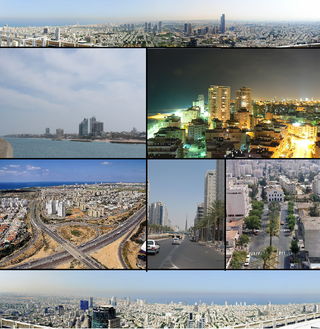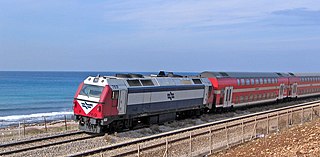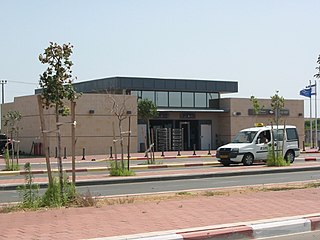
Gush Dan or Tel Aviv metropolitan area is a conurbation in Israel, located along the country's Mediterranean coastline. There is no single formal definition of Gush Dan, though the term is in frequent use by both governmental bodies and the general public. It ranges from combining Tel Aviv with cities that form an urban continuum with it, to the entire areas from both the Tel Aviv District and the Central District, or sometimes the whole Metropolitan Area of Tel Aviv, which includes a small part of the Southern District as well. Gush Dan is the largest conurbation and metropolitan area in Israel and the center of Israel's financial and High technology sector. The metropolitan area having an estimated population of 4,156,900 residents, 89% of whom are Israeli Jews.

The Tel Aviv Light Rail, also known as Dankal is a mass transit system for Gush Dan, the Tel Aviv metropolitan area in central Israel. The system will include different modes of mass transit, including rapid transit (metro), light rail transit (LRT), and bus rapid transit (BRT). Overseen by NTA Metropolitan Mass Transit System Ltd., a government agency, the project will complement the intercity and suburban rail network operated by Israel Railways.

Highway 20, more commonly known as the Ayalon Highway, or simply Ayalon, is a major inter city freeway in Gush Dan, Israel. The road runs along the eastern border of central Tel Aviv from north to south and connects all of the major highways leading to the city—such as Highway 4 from Ashdod and the Southern regions, Highway 2 from Haifa and the Northern regions, Highway 5 from the East, and Highway 1 from Jerusalem and the Southeast. The Ayalon Highway is heavily used; on an average day, almost 600,000 vehicles enter the freeway. It consists of a multi-lane highway with a multi-track railway located between the opposite travel lanes. Some of the highway's route is along the Ayalon River, hence its name. It is made of primarily asphalt.

Rishon LeZion–HaRishonim railway station is a station of Israel Railways in Rishon LeZion, part of the Tel Aviv – Rishon LeZion line. The station is located in the southern area of the city, in the middle of HaRishonim Interchange, at the intersection of the new Highway 431 and Route 412. It was opened on September 13, 2003, with the Beit Shemesh railway station. The station has two platforms. It is the southern terminus of the suburban line to Netanya.

Rail transport in Israel includes heavy rail as well as light rail. Excluding light rail, the network consists of 1,511 kilometers (939 mi) of track, and is undergoing constant expansion. All of the lines are standard gauge and as of 2023 approximately one-fifth of the heavy rail network is electrified, with additional electrification work underway. A government owned rail company, Israel Railways, manages the entire heavy rail network. Most of the network is located on the densely populated coastal plain.

The Tel Aviv transportation system is seen as the hub of the Israeli transport network in terms of road, rail, and air transport. The Israeli road network partly centers on Tel Aviv, with some of the country's largest highways passing through or running to the city. The city forms a major part of the country's rail network, whilst Ben Gurion International Airport located near the city is the country's largest airport. There is also a strong public transport system within the city, based primarily on bus transportation.

The Tel Aviv–Jerusalem railway is a railway line in Israel connecting the cities of Tel Aviv and Jerusalem. The line serves as the main rail link between the two cities, complementing the old Jaffa–Jerusalem railway. As such, the railway is often referred to in Israel as the high-speed railway to Jerusalem to distinguish it from the older, longer and slower line. In spite of that name, the line is not high-speed under the definition used by the International Union of Railways: both its design speed of 200 km/h (125 mph) and its current operational speed of 160 km/h (99 mph) are below the 250 km/h (155 mph) threshold used by the UIC to define high-speed railways, and it is traversed by IR's regular rolling stock instead of the UIC requirement for specially-designed high-speed trains.

The Red Line is the first section of a light rail system in the Tel Aviv metropolitan area, known as the Tel Aviv Light Rail. The line runs from Bat Yam in the south to Petah Tikva in the northeast with a significant portion of it underground. The total cost of the red line is estimated at NIS 11 billion or, approximately US$3 billion. Construction began in 2011, with the testing phase of the line beginning only a decade later, in 2021. After numerous delays concerning the security and safety of the line, it eventually opened on August 18, 2023 with a 100,000+ daily ridership over just 8 hours of operation.

Route 412 is a regional road in the south-east of the Tel Aviv Metropolitan Area in Israel. The road connects Bilu Junction south of Rehovot, with Yehud Ma'arav Junction, running through Rehovot, Ness Ziona, Rishon LeZion and Beit Dagan and spanning a distance of approximately 22 km.

The Coastal railway line is a mainline railway in Israel, which begins just south of the Lebanon-Israel border on the Mediterranean coast, near the town of Nahariya in Northern Israel and stretches almost the entire Mediterranean coast of the country, to just north of the border with the Gaza Strip in the south.
Transport in Bnei Brak occupies a central location within the Gush Dan. It has an important role in transport throughout the region.

Yavne East railway station is one of two railway stations in Yavne, Israel. It is on the suburban line Binyamina/Netanya–Tel Aviv–Rehovot/Ashkelon. Yavne East was opened in 1992 and was fully rebuilt in 2009.

Holon Junction railway station is a railway station on the Rosh HaAyin–Beersheba line. The station is located at the Holon Interchange which separates Tel Aviv from its southern suburb Holon.

Holon–Wolfson railway station is a railway station in the border of Holon and Jaffa in the south of Tel Aviv-Yafo Municipality, on the Rosh HaAyin–Beersheba line. The station is in the Wolfson interchange on the Ayalon Highway, nearby Wolfson Medical Center.

Bat Yam–Yoseftal railway station is a railway station on the Rosh HaAyin–Beersheba line. It is located at the Yoseftal interchange on the Ayalon Highway, on the border between Bat Yam and Holon, just south of Tel Aviv, Israel.

Bat Yam-Komemiyut railway station is a railway station on the Rosh HaAyin–Beersheba line in Israel. It is located at the Komemiyut interchange of the Ayalon Highway, on the border between Bat Yam and Holon.

Yavne West railway station is a passenger railway station in Yavne, Israel and is one of two railway stations in the city. The station is located between the Rishon LeZion Moshe Dayan railway station to the north and the Ashdod railway station to the south.
The 2013–14 Israel State Cup was the 75th season of Israel's nationwide football cup competition and the 60th after the Israeli Declaration of Independence. It began in August 2013, while the final was held in Ramat Gan Stadium on 7 May 2014.
The Lod–Ashkelon railway is a railway line linking Lod and Ashkelon. It is operated by Israel Railways, and spans approximately 50 km of mostly double track in central and southern Israel.

The Rishon LeZion–Modi'in railway is a railway project under construction linking the cities of Rishon LeZion and Modi'in in central Israel. The project will form a part of Israel Railways' suburban rail network serving the Tel Aviv metropolitan area, as well as provide an east-west connection between the Tel Aviv–Ashkelon, Tel Aviv–Beersheba and Tel Aviv–Jerusalem rail corridors. The fully electrified line will be 30 km (19 mi) long, and involve the construction of two new train stations and Israel's longest railway viaduct.
















